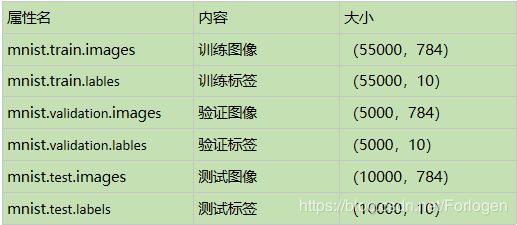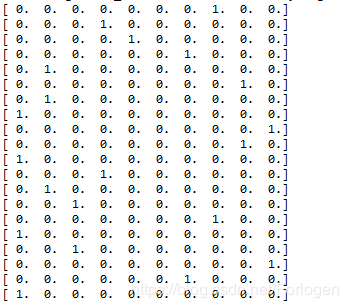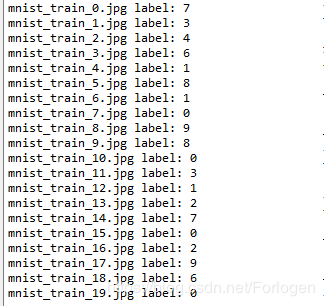tesnsorflow学习-MNIST数据及项目
MNIST是一个手写字符的数据集,主要有一些手写数字的图片和相应的标签组成包含如下四个文件:

四个文件中,前两个是训练图像,一共60000张,后两个是测试图像,一共10000张。下载该数据集:
# form tensorflow.examples.tutorials.mnist import a module
from tensorflow.examples.tutorials.mnist import input_data
#Reading datas of MNIST from MNIST_data,if this statement id not exist,it will download bu ifself
mnist = input_data.read_data_sets("MNIST_data/",one_hot = True)
通过下载数据,我们可以得到一个mnist的对象,它的属性含义如下:

在mnist.train.labels中,大小维(55000,10),每个标签都用一个10维的向量表示0-9,向量中只有一个元素为1,来区分类别,这就是标签的独热(one-hot)表示。输出图像的标签信息:print (mnist.train.labels[i,:])


我们可以输出数据集的相关信息:
#Reading the shape of train datasets
print ("The shape of train_images:",mnist.train.images.shape)
print ("The shape of train labels:",mnist.train.labels.shape)
#Reading the shape of validation datasets
print ("The shape of validation images:",mnist.validation.images.shape)
print ("The shape of validation labels:",mnist.validation.labels.shape)
#Reading the shape of test datasets
print ("The shape of test images:",mnist.test.images.shape)
print ("The shape of test labels:",mnist.test.labels.shape)
output:

在原始数据集中,每张图片都是2828维的矩阵表示,在tensorflow中每张图片都由784维的向量表示(784=2828)我们可以将其转换成图片保存:
"""
# -*- coding: utf-8 -*-
Created on Wed Sep 26 19:27:28 2018
@author: dyliang
"""
#导入库
from tensorflow.examples.tutorials.mnist import input_data
import scipy.misc
import os
#加载数据集
mnist = input_data.read_data_sets("MNIST_data/",one_hot = True)
#创建保存图片的路径
save_dir='MNIST_data/raw/'
#如果系统中不存在,则会自动创建
if os.path.exists(save_dir) is False:
os.makedirs(save_dir)
#保存前20张图片
for i in range(20):
#保存第i张图片 mnist.train.images[i,:]
image_array = mnist.train.images[i,:]
#将tensorflow中784维向量的图片还原成28*28维的图像
image_array = image_array.reshape(28,28)
#保存文件,格式为 mnist_train_0.jpg,mnist_train_1.jpg,...,mnist_train_19.jpg
filename = save_dir + 'mnist_train_%d.jpg'%i
#用scipy.misc.toimag转换为图像,调用.save()保存
scipy.misc.toimage(image_array,cmin = 0.0,cmax = 1.0).save(filename)
output:

在tensotflow下使用softmax回归进行分类:
# -*- coding: utf-8 -*-
"""
Created on Wed Sep 26 20:23:15 2018
@author: dyliang
实现利用tensorflow中的softmax回归实现图片的分类
"""
import tensorflow as tf
from tensorflow.examples.tutorials.mnist import input_data
mnist = input_data.read_data_sets("MNIST_data/",one_hot = True)
"""
创建占位符 x ,代表待识别的图片
def placeholder(dtype, shape=None, name=None):
tf.float32:是tf的类型
[None,784]:是shape数据,None表示可以是任意维
"""
x = tf.placeholder(tf.float32,[None,784])
"""
tensorflow中变量的参数用tf.Variable表示
w:是softmax回归中的参数,将784维的输入转换成10维的输出,初始是784*10的全零矩阵,(784,10)
b:偏置项,初始维10维的0向量,(10,)
"""
w = tf.Variable(tf.zeros([784,10]))
b = tf.Variable(tf.zeros([10]))
"""
y 和 y_ 是两个Tensor
y:模型的输出,根据公式 y = wx + b , (N,10)
y_ :实际的图像标签,以占位符表示,独热表示
"""
y = tf.nn.softmax(tf.matmul(x,w) + b)
y_ = tf.placeholder(tf.float32,[None,10])
"""
softmax回归中使用交叉熵衡量数据的相似性
根据y和y_来计算交叉熵
"""
cross_entropy = tf.reduce_mean(-tf.reduce_sum(y_ * tf.log(y)))
"""
使用梯度下降法针对模型的参数w和b进行优化,默认会对所有的参数计算梯度
计算梯更新w和b的值
0.01 是learning rate
"""
train_step = tf.train.GradientDescentOptimizer(0.01).minimize(cross_entropy)
"""
创建一个Session,进行优化步骤
"""
sess = tf.InteractiveSession()
"""
运行前必须要初始化所有的变量,分配内存
在session中保存计算过程中的变量值
"""
tf.global_variables_initializer().run()
"""
利用梯度下降进行优化
1000步
"""
for _ in range(1000):
"""
取1000个训练数据
batch_xs:(100,784)的图像数据
batch_yes:(100,10)的实际标签
对应两个占位符 x 和 y_
"""
batch_xs,batch_yes = mnist.train.next_batch(100)
sess.run(train_step,feed_dict = {x : batch_xs,y_ : batch_yes})
"""
correct_prediction:正确的预测结果
accuracy:准确度,都是Tensor
tf.argmax:提取向量中最大值的下标,将其转换为数字标签
"""
correct_prediction = tf.equal(tf.argmax(y,1),tf.argmax(y_,1))
accuracy = tf.reduce_mean(tf.cast(correct_prediction,tf.float32))
print (sess.run(accuracy,feed_dict={x:mnist.test.images,y_:mnist.test.labels}))
结果为:
使用数据集构建一个简单的神经网络模型
# -*- coding: utf-8 -*-
"""
Created on Mon Oct 8 09:07:03 2018
@author: dyliang
"""
#输入数据,导入MNIST数据集
from tensorflow import keras
#from keras.datasets import mnist
#加载训练数据和测试数据
(train_images,train_labels),(test_images,test_labels) = keras.datasets.mnist.load_data()
#打印一些信息
print (train_images.shape)
print (len(train_labels))
print (test_labels)
print (test_labels.dtype)
print (train_images.ndim)
#打印某一个数据,这里是一张图片
digit = train_images[4]
import matplotlib.pyplot as plt
plt.imshow(digit,cmap=plt.cm.binary)
plt.show()
#构建网络
#from keras import models
#from keras import layers
#包含两个Dense层
model = keras.Sequential([
keras.layers.Dense(512, activation='relu', input_shape=(28 * 28,)),
keras.layers.Dense(10, activation='softmax')
])
#网络的编译,指定优化器、损失函数和监控的指标
model.compile(optimizer='rmsprop',
loss='categorical_crossentropy',
metrics=['accuracy'])
#准备图像数据,将其变换成网络要求的形状,。并缩放到所有值都在【0,1】之间
train_images = train_images.reshape((60000, 28 * 28))
train_images = train_images.astype('float32') / 255
test_images = test_images.reshape((10000, 28 * 28))
test_images = test_images.astype('float32') / 255
#循环训练网络
from tensorflow.python.keras.utils import to_categorical
train_labels = to_categorical(train_labels)
test_labels = to_categorical(test_labels)
#利用fit方法训练,迭代5次,批量大小为128
model.fit(train_images, train_labels, epochs=5, batch_size=128)
#检查在测试集上的性能
test_loss,test_acc = model.evaluate(test_images,test_labels)
print ('test_loss:', test_loss)
print ('test_acc:' ,test_acc)
输出结果
